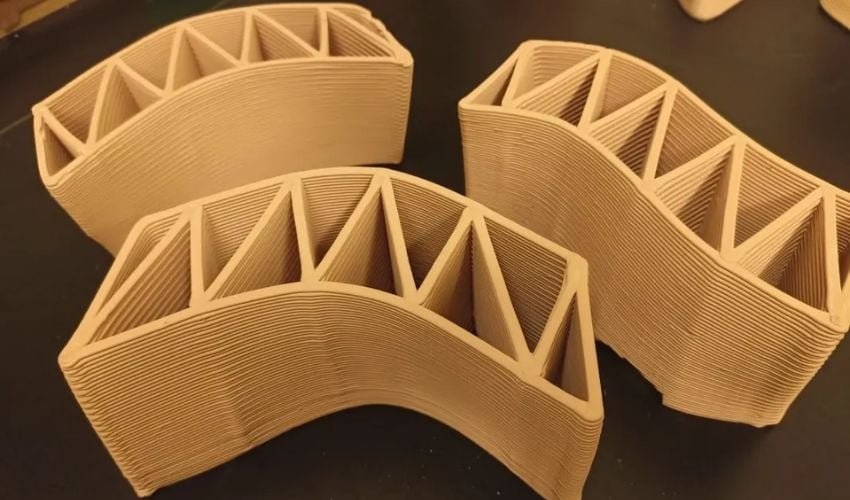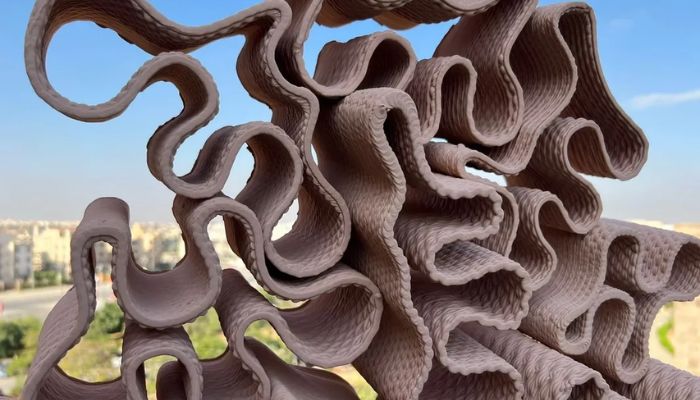3D Printed Clay Bricks Aim For Sustainable, Eco-Friendly Construction

In recent years, 3D printed structures and housing construction projects have been growing around the world both in scale and scope. Depending on the materials used, 3D printed buildings offer multiple advantages over conventional construction, including fire resistance, local or recyclable materials, lower overall costs, and of course, shorter build times to accommodate population growth in a more timely manner. At The American University in Cairo (AUC), researchers have been hard at work developing an additive manufacturing-based construction system of their own which prioritizes local construction materials, robotic fabrication, and a strong push towards carbon-zero manufacturing. The result? Their 3D printed clay brick project’s success has been the first of its kind for North Africa and provides a glimpse at the potential in the region.
The researchers are at one of only three labs that are currently experimenting with clay bricks in Africa and the Middle East. More specifically, the metal and clay material-based method of additive manufacturing was developed through a collaboration between the AUC’s Additive Manufacturing Centennial Lab (AMCL) and the Robotic Fabrication Lab (RFL). This process is capable of utilizing robotic arms to build complex structures at a fraction of the cost in energy, time and emissions compared to traditional construction practices. Eschewing concrete mixtures which are commonly used for AM construction projects, the team has opted for what they term a specialized red fire clay which is more durable and resistant to heat than normal clay due to its composition which includes minerals such as feldspar, quartz and kaolin. The mixture can then be easily extruded into the desired shapes using the team’s large-scale robotic 3D printing apparatus.

The 3D printed clay is more resistant to heat and able to hold complex shapes (photo credits: The American University in Cairo RFL)
The use of clay plays a critical role in the team’s vision and commitment to sustainability. Based in Egypt, the team is well aware that clay (and the material to make clay) is found in abundance, as traditionally produced clay bricks have been used in the region since time immemorial. The upshot for the AUC team is a steady supply of local materials to work with on an as-needed basis. Indeed, the positive impacts have been touted by the team who predict the technology will help stimulate the local economy while providing readily available and more affordable housing to those in need.
“AM, in fact, will integrate with traditional manufacturing to complement it rather than replace it. With AM, there is the freedom to design, inspire innovation and positively impact society in an eco-friendly manner as well as reduce the drain of [foreign] currency. It will also provide companies with the means to limit outsourcing to third parties by developing concepts in-house and creating an advantage over competitors by shortening the product development cycle,” explains Professor Hanadi Salem, AUC Department of Mechanical Engineering chair.
More Value, Less Waste With 3D Printed Clay
Visually pleasing and able to be shaped into curves and more complex geometric patterns, this red fire clay holds several benefits that make it an ideal material for green construction, especially when combined with additive manufacturing. As RFL director Professor Sherif Abdelmohsen elaborates, “It is much more efficient in producing bricks compared to traditional methods, as it eliminates the need for manual molding and firing. It also generates less waste, as any unused or scrap material can be easily recycled and reused. It allows for greater control over the production process, resulting in bricks with consistent quality, strength, and durability.”
The clay bricks and other various pieces produced by the team were presented last November at the 2022 United Nations Climate Change Conference (COP27). Their pieces showcased at COP27 and in the intervening time have highlighted the unique design and potential of this construction material. For more information about the AUC and their projects, you can check their website HERE.
What do you think of 3D printed construction materials? Let us know in a comment below or on our LinkedIn, Facebook, and Twitter pages! Don’t forget to sign up for our free weekly Newsletter here, the latest 3D printing news straight to your inbox! You can also find all our videos on our YouTube channel.
*Cover Photo Credits: American University in Cairo RFL






